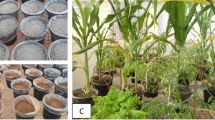Abstract
In the Boundary Waters Canoe Area Wilderness, the movement of fecal bacteria, N, and P from pit latrines was studied, as well as the effectiveness of peat latrine liners in reducing this movement. When latrines are constructed where only a thin layer of permeable soil overlies bedrock or other impermeable material, fecal bacteria can be carried considerable distances by subsurface flow. Lining latrine pits with acid peat appears to reduce bacteria transport. Most soils strongly adsorb P and prevent its movement. In this study no movement of P from latrine pits was seen except at one site with very sandy soil. In such soil a peat liner appears to be of some value, if a peat with a high P adsorption capacity is used. A peat liner should be viewed as an additional protection against P and bacteria movement rather than as a substitute for proper soil conditions. Latrines should not be built in thin, rocky soils. Nitrogen appears to move readily from toilet pits, regardless of soil type or presence of peat liners. But, because of dilution, N is not likely to have a discernible impact on water quality.
Similar content being viewed by others
References
American Public Health Association: 1976,Standard Methods for the Examination of Water and Wastewater, 14th ed. American Public Health Association, Washington, D.C. 1193 p.
Beard, P. H.: 1940,Am. J. Public Health 30, 1077.
Black, C. A.: 1965,Methods of Soil Analysis, Part II, American Society of Agronomy, Madison, Wis. 1572 p.
Caldwell, E. L.: 1937,J. Infectious Diseases 61, 269.
Caldwell, E. L.: 1938,J. Infectious Diseases 62, 273.
Caldwell, E. L. and Parr, L. W.: 1937,J. Infectious Diseases 61, 149.
Cuthbert, W. A., Panes, J. J., and Hill, E. C.: 1950,J. Appl. Bacteriol. 18, 408.
Farnham, R. S. and Brown, J. L.: 1972, ‘Advanced Wastewater Treatment Using Organic and Inorganic Materials’, Part 1. Use of Peat and Peat-Sand Filtration Media.Proc. 4th Internat. Peat Congress. Otaniemi, Finland, Vol. 4, p. 271.
Fox, R. L. and Kamprath, E. J.: 1971,Soil Sci. Soc. Am. Proc. 35, 154.
Geraghty, J. J., Miller, D. W., Van Der Leeden, F., and Troise, F. L.: 1973,Water Atlas of the United States, Water Information Center, Inc., Port Washington, N.Y.
Gerba, C. P., Wallis, C., Melnich, J. L.: 1975,J. Irrig. Drain. Div., ASCE 101, 157.
Grahek, J. P.: 1981, private communication from a MD.
Hagedorn, C., McCoy, E. L., and Rahe, T. M.: 1981,J. Environ. Qual. 10, 1.
Hendricks, D. W., Post, F. J., and Khairnar, D. R.: 1979,Water, Air, and Soil Pollut. 12, 219.
Kaila, A.: 1959,J. Sci. Agric. Soc. Finland 31, 215.
King, J. G. and Mace, Jr., A. C.: 1972,Minnesota Volunteer 35 (205), 57.
King, J. G. and Mace, Jr., A. C.: 1974,J. Water Pollut. Contr. Fed. 46, 2453.
Larsen, J. E., Langston, R., and Warren, G. F.: 1958,Soil Sci. Soc. Proc. 22, 558.
Laverty, J. C.: 1963,Soil Sci. Soc. Am. Proc. 27, 360.
McCool, M. M.: 1921,Mich. Quart. Bull. 3, 126.
McCoy, E. L. and Hagedorn, C.: 1980,J. Environ. Qual. 9, 686.
Miller, M. H.: 1979,J. Environ. Qual. 8, 42.
Otis, R. J., Boyle, W. C., Clements, E. V., and Schmidt, C. J.: 1980,Design Manual: ‘On Site Wastewater Treatment and Disposal Systems’, Report EPA-625/1–80–012, U.S. Environmental Protection Agency, Washington, DC. 391 p.
Ponce, S. L. and Gary, H. L.: 1979,Res. Pap. RM-211, USDA Forest Service, Rocky Mountain Forest and Range Experiment Station, Fort Collins, CO. 10 p.
Rahe, T. M., Hagedorn, C., McCoy, E. L., and Kling, G. F.: 1978,J. Environ. Qual. 7, 487.
Reddy, K. R., Khaleel, R., and Overcash, M. R.: 1981,J. Environ. Qual. 10, 255.
Sikora, L. J., Frankos, N. H., Murray, C. M., and Walker, J. M.: 1980,J. Environ. Eng. Div., ASCE 106, 351.
Stiles, C. W. and Crohurst, H. R.: 1923,Public Health Report 38, 1350.
Surakka, S. and Kamppi, A.: 1971,Suo 22, 51.
U.S. Environmental Protection Agency: 1976,Methods for Cemical Analysis of Water and Wastes, Report EPA-625/6–74–003a, U.S. Environmental Protection Agency, Environmental Research Center, Cincinnati, OH. 298 p.
Vollenweider, R. A.: 1968,Scientific Fundamentals of the Eutrophication of Lakes and Flowing Waters with Particular Reference to Nitrogen and Phosphorus as Factors in Eutrophication, Organization for Economic Cooperation and Development, Paris, France. 357 p.
Warrick, L. F. and Muegg, O. J.: 1930,J. Am. Water Works Assoc. 22, 215.
Wondrausch, J.: 1969,Polish J. Soil Sci. 11, 97.
Author information
Authors and Affiliations
Rights and permissions
About this article
Cite this article
Nichols, D.S., Prettyman, D. & Gross, M. Movement of bacteria and nutrients from pit latrines in the boundary waters canoe area wilderness. Water Air Soil Pollut 20, 171–180 (1983). https://doi.org/10.1007/BF00279627
Received:
Revised:
Issue Date:
DOI: https://doi.org/10.1007/BF00279627




